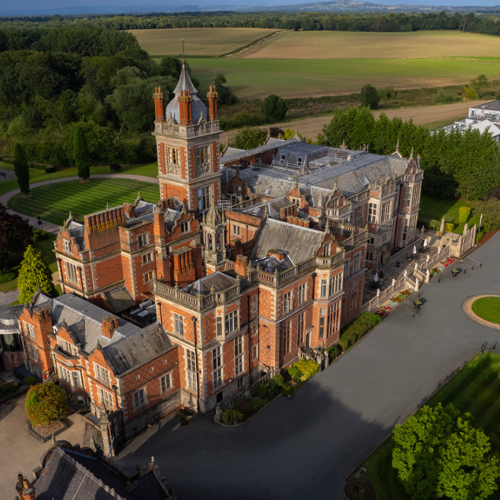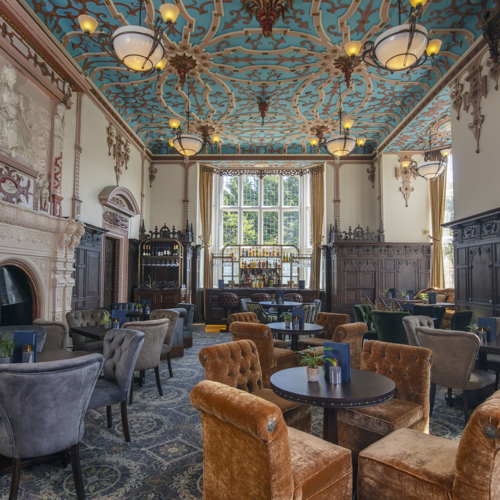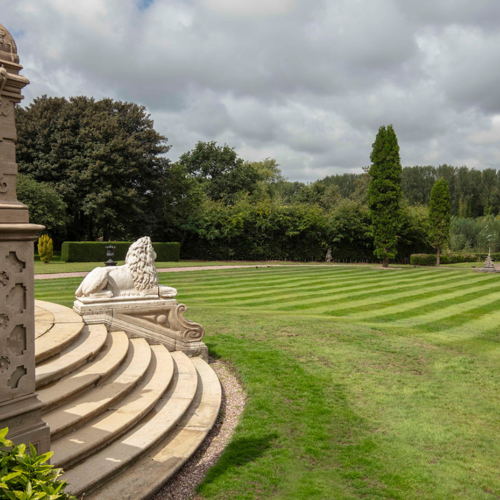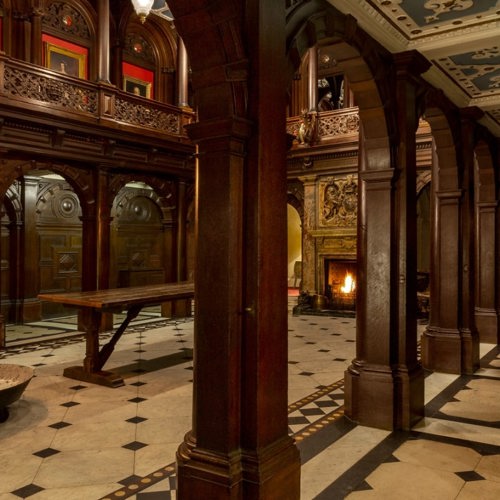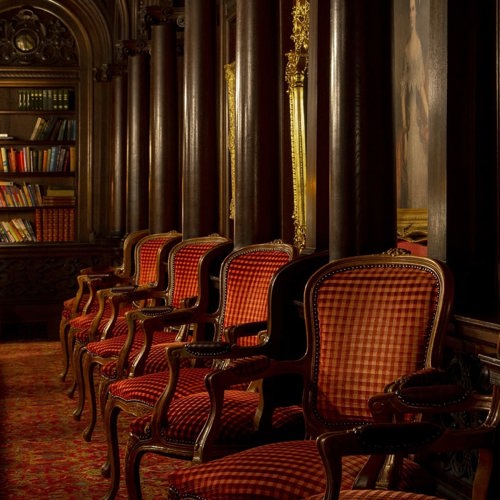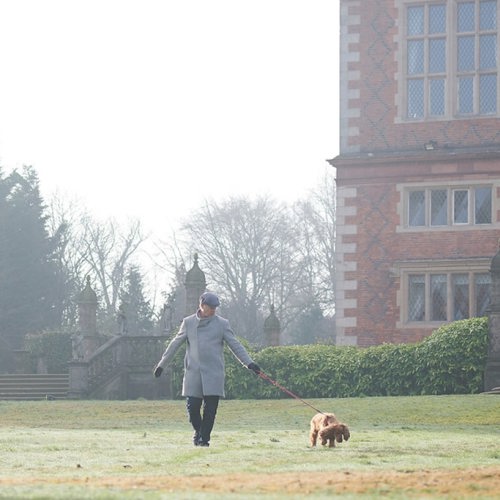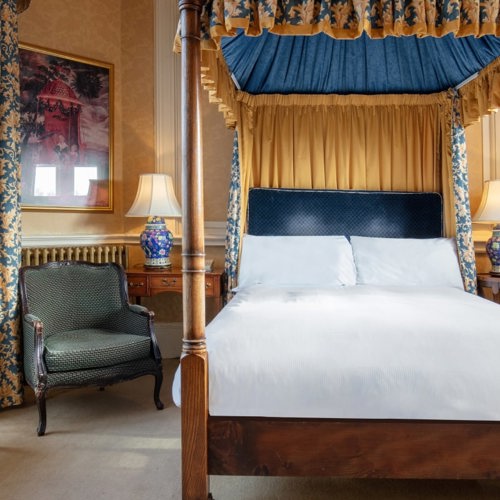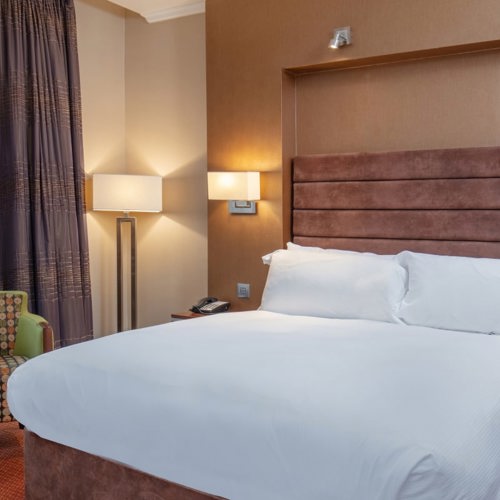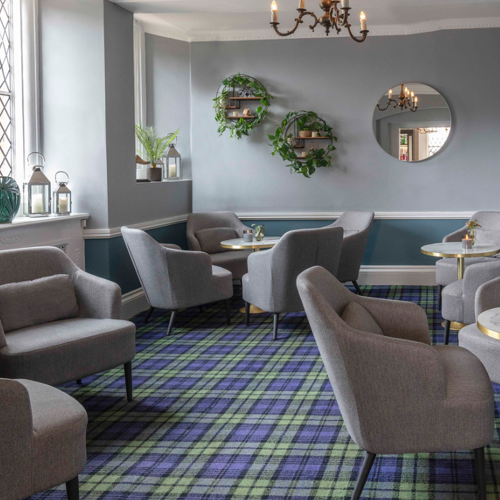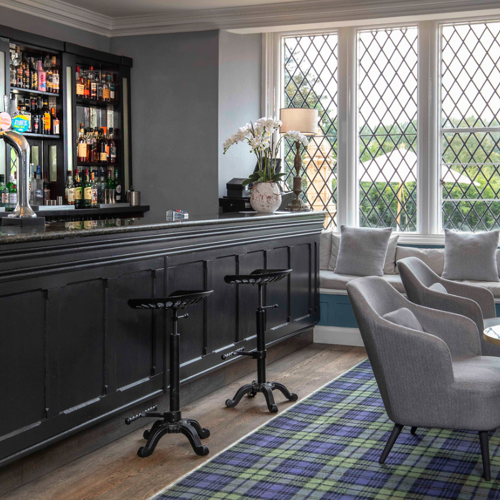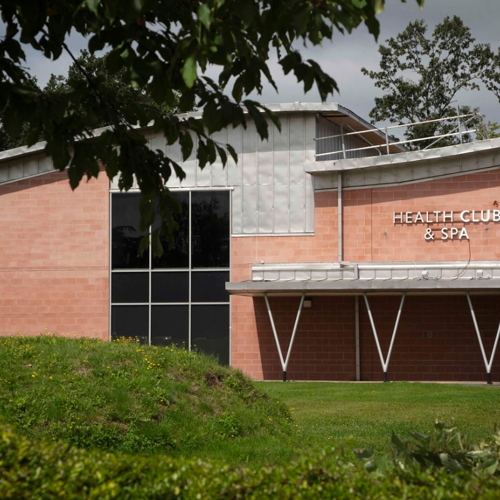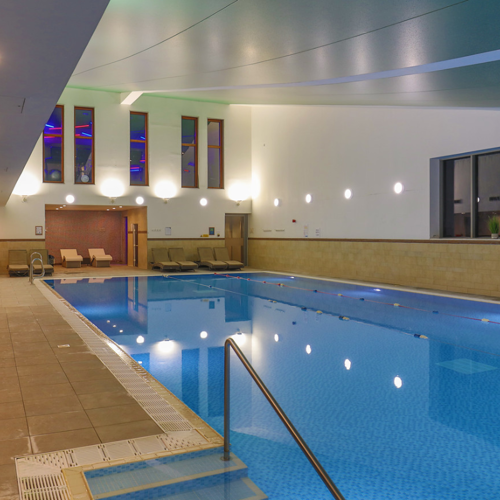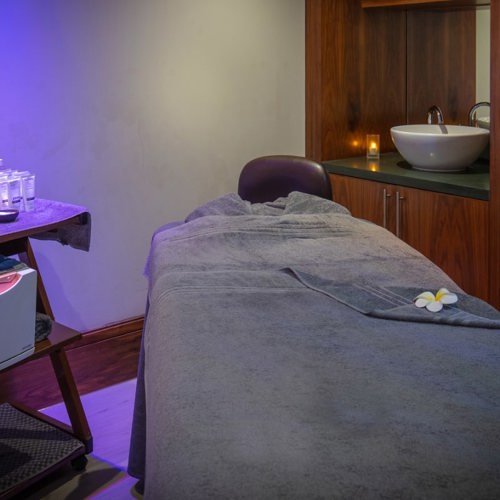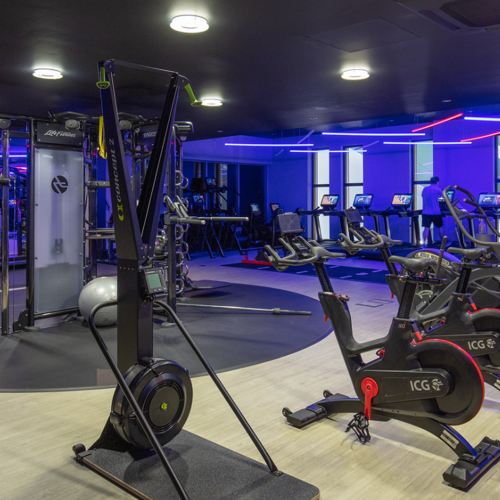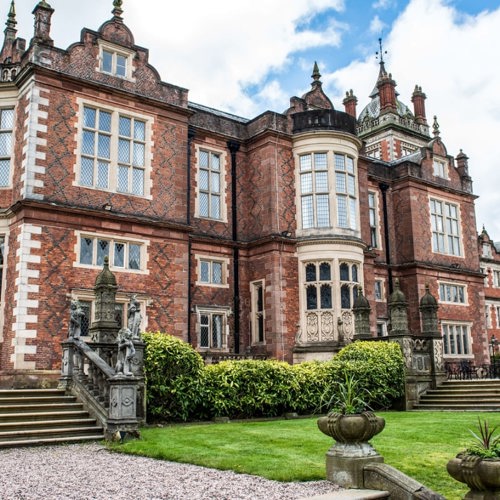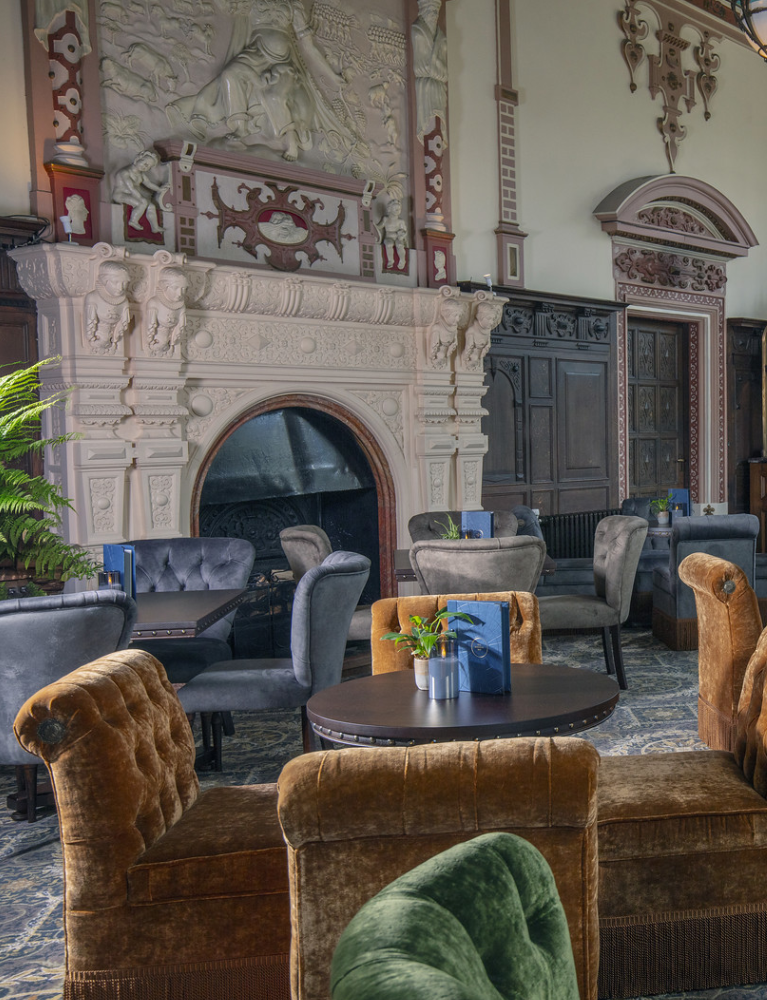
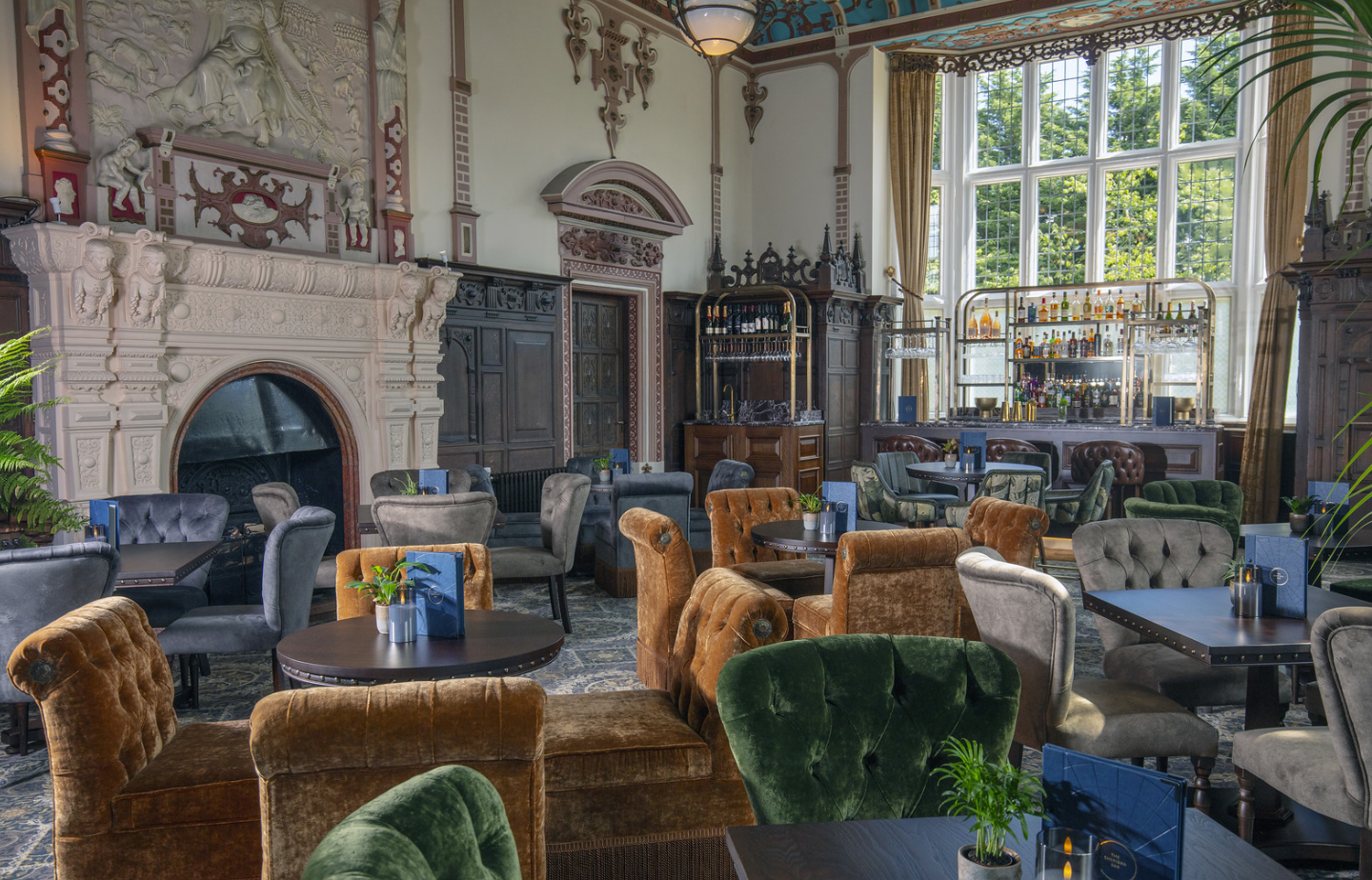
The History of Crewe Hall, Cheshire
Set in eight acres in the peaceful Cheshire countryside, Crewe Hall Hotel & Spa is steeped in rich history.
Originally built in the 17th century, the hotel has gone on to survive a fire, host the military during World War II, and even receive a visit from Her Majesty the Queen in 1955.
DELVE INTO OUR HISTORY
The site of the mansion dates back as far as 1170 and came into the Crewe Family in 1608; the mansion was in a very bad state of decay that in 1615 Sir Randolph Crewe had it demolished and re-built. It was complete some 21 years later in 1636 and the general character of the mansion owes much to the employment of Flemish, Italian and other foreign craftsmen. It was restored and extended in 1837.
In 1866 the interior of Crewe Hall was very badly damaged by fire and was caused by one of the wooden beams under the fireplace in the long gallery catching alight. The rebuilding within the existing walls which survived the fire, was entrusted by Hungerford. Third Baron Crewe to Edward Barry; son of the architect to the Houses of Parliament. Edward Barry was architect to many famous buildings such as Covent Garden Theatre, Great Ormond Street Childrens' Hospital, Charing Cross Station and was the architect in charge from 1860 - 1870 for final work on the Houses of Parliament. Hungerford Crewe could not resist temptation to add a wealth of mid-Victorian ornamentation and stone was replaced by alabaster and marble; leaded panes gave way to stain glass windows and elaborate designs were executed in plasterwork.
Prior to 1922 when the Crewe family left, there would have been around 100 servants in the hall - it had 190 rooms. There were 20 gardeners growing all the produce for the house in the 3 walled garden and there was the Home Farm which had approximately 50 farms and 200 cottages in the immediate locality.
In 1931 when this type of living was on the decline and mainly because Lord Crewe had no heir to the title, only two daughters, he offered the Hall and the surrounding estates to Cheshire County Council, but they declined the offer. Lord Crewe eventually sold the Hall and the bulk of the estate to the Duchy of Lancaster in 1936.
In 1955 Her Majesty The Queen, together with the Duke of Edinburgh visited Crewe Hall in her capacity as Duke of Lancaster, whilst touring the Duchy Estates in Cheshire.
From 1939 - 1946 Crewe Hall was occupied by the War Department and many Australian, Canadian and American troops were housed in the Hall at various times throughout the last three years of military occupation. It was used as a prisoner of war camp for over 2,000 high ranking German officers.
Until 1998 Crewe Hall remained the property of Duchy of Lancaster, and, as such belonged to the Crown.
Just inside the main front door is the Reception Hall with its monumental fireplace of veined marble with the word 'Welcome' carved boldly above the Crewe Insignia, surrounded by heraldic lions and Finials also in marble. This dates from 1870 - the year that the Victorian rebuilding of Crewe Hall was completed. The rebuilding resulted from a serious fire in 1866 which gutted almost the whole of the inside of the house.
The original Crewe Hall was Jacobean, being built between 1615 - 1636 by Ranulph Crewe, son of a merchant who lived in Nantwich. In its' early form, the Reception Hall had a low ceiling with bedrooms above; but the 1870 rebuilding to the design of an eminent architect of the day, Edward Barry, enabled his employer Hungerford, the 3rd Lord Crewe to achieve this very finely proportioned hall which we see today.
Notice too, the richly designed ceiling and the display of virtues (with which the Victorians were very much pre-occupied)! Nevertheless, the six maidens, Humility, Charity, Temperance, Truth, Chastity and Patience are indeed beautifully painted. The stained glass in the windows here are the ecclesiastical arms of Chester, York, Durham and Carlisle.
Above the front doors is a Minstrels Gallery. Having no staircase, the only access is by ladder through a hinged portion of the balcony. It has all the high standard of decoration as the rest of the Reception Hall - with ornate carved wood, strapwork plaster ceiling and stained-glass window lights - even though it remains largely unseen. The coat of arms above the fireplace is that of Hungerford, 3rd Lord Crewe with the traditional "White Lion Rampant" of the Crewe Family.
This room is particularly interesting because there is some of the original panelling that survived the great fire of 1866. This room is entirely wainscoted in oak and has a decorated ceiling.
It was from here that the Steward carried out his Master's business.
Well worthy of observation in this room is the chimney piece being mainly of oak and ornamented with a profusion of interlaced scroll work. The top has interwoven carvings of the lion, shamrock and thistle, and it is interesting to note that it was during the time when Crewe Hall was being built, in the reign of James I (1603 - 1625) that the symbols of the three kingdoms were first united. The lower part of the chimney is marble and relatively new.
In the Marble Hall can be seen again the work of the Victorian architect Barry superimposing the elaborate intricacies of carving and plaster decoration with a grand ornamented fireplace. In the Jacobean building this was an inner courtyard area - open to the sky - and in a modification to the Hall by the architect Blore in 1837 a single storeyed roof was created. However, the re-design after the 1866 fire gave Barry the opportunity to open up the Marble Hall and create this splendid galleried area with its hammer beam roof.
The fireplace here in the Marble Hall is not only finely sculptured and decorated with the Crewe arms but is also unique in that the chimney shaft at the rear also forms the arch for the passageway. The fireplace is also decorated with the two Crewe mottoes of "Quid Retribuam Domino" (what shall I render unto the Lord) and "Sequor nec Inferior" (I follow but not inferior).
Another five generations later in 1894, Hungerford, 3rd Lord Crewe died a bachelor and the title of Crewe went to his nephew Lord Houghton. That Lord Crewe was created Marquess of Crewe in 1911 and when he died in 1945 the line was extinguished. He had daughters who had children.
From the landing we look over the East Hall. Here we have more of the fine stained glass from 1870, which shows up well in the daylight. It depicts certain of the marriages of the Crewe family, starting with Sir Ranulph Crewe on the left and following with the four subsequent ones. In the medieval battlefield, the coat of arms was doubtless important for recognition purposes, but the crest would have possibly given more significance. So it was paramount to a noble family to display their crest.
As mentioned earlier, the arms of the Crewes showed a White Lion Rampant - this was a symbol much used by the hostelries. Traditionally, it was supposed to indicate that it had been given a "seal of approval", by the noble lord - rather like a mediaeval AA rating!
Whilst there is no written record of it, we think it possible that in the Jacobean building, this East door may have been used as the main entrance to the Hall.
The pedigree board over the fireplace here, which was restored after the fire, shows the record of Crewe marriages up to 1663.
Here in the Chapel there is such wealth of decoration, it is difficult to decide where to begin. The twelve stained glass lights in the oriel window behind the altar depict the apostles. Below them, lining the circular wall of the reredos are heads of saints and prophets exquisitely carved in alabaster.
On the altar floor is the Crewe motto in the original gold leaf. The sacrarium arch setting off the whole is of alabaster and marble with incised patterning.
When services were conducted, the Crewe family sat in their own pew in the gallery above which they entered through their own private door upstairs. The duties of the resident parson included the education of the Crewe's children in addition to ministering to the spiritual needs of the family and their servants. Along each wall of the Chapel are ten bronze heads of Biblical figures - each one an individual work of art. The moulds have doubtless long since been broken. The name of the sculptor, a Mr J Philips is carved in the alabaster heads behind the altar.
The roof is termed a "wagon roof" because the wooden segments create the panelled appearance of an old farm wagon. In each segment are the Symbols of the Passion including - the 30 pieces of silver, gambling dice, hammer, nails, the cock that crowed and the Cross itself.
The Chapel was consecrated in 1635 by the Bishop of Chester, Dr John Bridgman and still remains consecrated to this day.
This was constructed in an open well, the style originates from Spain. The solid oak balustrades are highly enriched with carvings and the heraldic beasts are mounted on pillars all the way up the staircase.
This was the Dining Room for the Main Hall. The most remarkable feature of this room is the profusely carved oak screen in mixed styles, which gives the room an appearance of a college hall. In olden days, there would be a dais below the screen in which the principal table was situated. It is thought that this magnificent screen is the most perfect of its kind still in existence. The room is spacious, lofty, and well-proportioned in all respects, having a magnificently decorated ceiling enriched with pendants.
The bottom part of the fireplace is fairly new, while the upper section contains a remarkable plaster figure signifying 'Wisdom'.
Possibly before the restoration of the hall, the minstrel’s gallery was situated over the oak screen and thus provided the diners with a view of the musicians. The room also had communications with the kitchen through a serving hatch at the end of the dining room.
Here, in the Carved Parlour is more evidence of Victorian decoration superimposed on the original Jacobean model. It was called the Carved Parlour because of this carved wood wainscot above which is a highly decorated frieze. The 1870 refurbishing transformed the cruder figures, in similar medallion mounts, into the sophisticated high-relief statuary seen here and titled as Victorian virtues. On the end wall we have the Elements, Earth, Air, Fire and Water.
Over the alabaster chimneypiece, Father Time chastises Sloth for his laziness and rewards Industry. In his left hand he holds a whip and rod which he presents to an indolent fellow in rags and lies stretched on the ground. Various symptoms of idleness are around him, gallows and gibbettree wait for him in the background, his fields are full of thistles and weeds, his trees are dead, and his house is sadly in need of repair. In his right hand, Time holds forth a crown to an industrious man who is seen hard at work digging. He has in the background a house like a castle, fields that produce an abundance of fruit and corn, trees rich in foliage, and a number of doves representing love and peace.
Surmounting all is a bust of Sir Ranulph Crewe, the builder of old Crewe Hall who is seen here in his robes of the office he held under James the First; that of Lord Chief Justice. His ermine robe and ruff collar are overlaid with the great Gold Seal.
Regrettably, he was to lose his high office in 1626 when King Charles dismissed him, due to his inability to agree with his monarch over the raising of revenue through forced loans.
The type of ceiling decoration is known as strapwork and it is made of plaster. It was used extensively in Jacobean times but was not coloured. At the Victorian restoration it was renewed in a more sophisticated fashion and was decorated as you see here.
This one has as its centrepiece an elliptical decorative plaster feature signifying Night.
Two glass panels in the wainscot on the wall farthest away from the window enabled the butler to observe from the passageway of the floor below whether his lordship was still in occupation.
In the centre of each carved section between the pillars round the balcony here, are seen the inter-twined "C's" of the Crewe crest along with the peer's coronet. The pillars contain cast iron down pipes necessary to drain water from the roof gulleys. Above the balcony is a strapwork ceiling in Wedgwood Blue. The Victorian refurbishing of Crewe Hall has resulted in a collection of strapwork ceilings which are among the best in the country.
The feature of particular interest here, are again the very fine strapwork ceiling and the chimneypiece of marble, jasper and onyx. The decoration in the carved stone around the concave oval is worthy of close inspection when you will see all manner of intricately carved butterflies, lizards, flowers and fruit. The tastefully carved oak wainscot and decorated plaster frieze set off this beautifully proportioned room which was furnished with exquisite taste in Victorian days. A succession of eminent literary, social and political personages would have been entertained here by the Crewes in year gone by, such as Richard Brinsley Sheridan, who was a regular visitor to Crewe and dedicated his play "School for Scandal" to Frances Crewe wife of the 1st Lord Crewe and celebrated beauty of the day.
The small Drawing Room is sometimes called the Withdrawing room. In Victorian times this provided perhaps a more comfortable setting for smaller gatherings. A beautifully furnished family sitting room with a lofty gilded ceiling - it is well proportioned with its low wainscoting and marble fireplace.
This is one of the loveliest rooms in the Hall. This room has perhaps the finest of our strapwork ceilings with a centre piece in a Wedgwood motif representing Aurora, Goddess of Dawn in a chariot with a winged cherub above and a robed figure scattering flowers in her path. The Crewe motif appears yet again on either side of the centrepiece. The peers coronet with the two intertwined "C's" is the same design as we see elsewhere in the Hall.
Decorated Mabey medallions in the frieze line the North and South walls. On the North wall (the one with the fireplace) are the English poets; and on the South wall, other great classical poets. In the coving between the Ceiling and the frieze is the named bust of the authors.
Stained glass panels of Charles I, Elizabeth I and James I complete the frieze at the western end of the room.
The Marquess of Crewe was said to have had a collection of 32,000 books and the shelves were certainly full in 1880 as evidenced by photographs of that date.
During World War 2 the Hall was leased to the War Department and was used as an Army Camp by both British and American troops and latterly as a prisoner-of-war camp for German Officers.
This is the largest room in the house. The traditional use for the Long Gallery in Jacobean times was for games, dancing and winter time exercises. In 1880 it was used for a more dignified use, at that time it was most tastefully furnished and functioned also as the Crewe family portrait gallery.
The room is very formal in design having a central bay window alcove, a central fireplace and four matching doorways. Two of the doorways are practical but the other two are false concealing very small cupboard spaces and were designed purely to maintain the symmetry of the room.
The bay window alcove is where King George V and Queen Mary breakfasted when they stayed at Crewe Hall in 1913. The view from here would have been over formal Italian gardens leading down to a large ornamental lake. The artificial lake drained away when the dam broke in 1941. From photographs of the Long Gallery and its' furnishings it is obvious that the Crewe family enjoyed a very opulent life style which involved servants in very long hour of work.
Prior to 1922 when the Crewe family left, there would have been around 100 servants in the Hall - it had 190 rooms. There were 20 gardeners growing all the produce for the house in the 3½ acre walled garden. There was the Home Farm and in addition approximately 50 farms and 200 cottages in the immediate locality. These comprised the estate sold to the Duchy of Lancaster in 1936 but in earlier days the Crewe's were said to own "half of Cheshire".
The fireplace here is the very one where the great fire of 1866 started. Recently, when this room was being renovated, fire blackened bricks were found behind the panelling. The figure over the fireplace are Sir Ranulph Crewe, the founder(on the left) and his brother Thomas' grandson, Bishop Crewe of Stene in Northamptonshire who was Bishop of York and later Durham.
On the Top Gallery you can see the stained-glass windows decorated with the Crewe armorials. The record of marriages in the hammer-beam roof can be seen through the open balcony.


